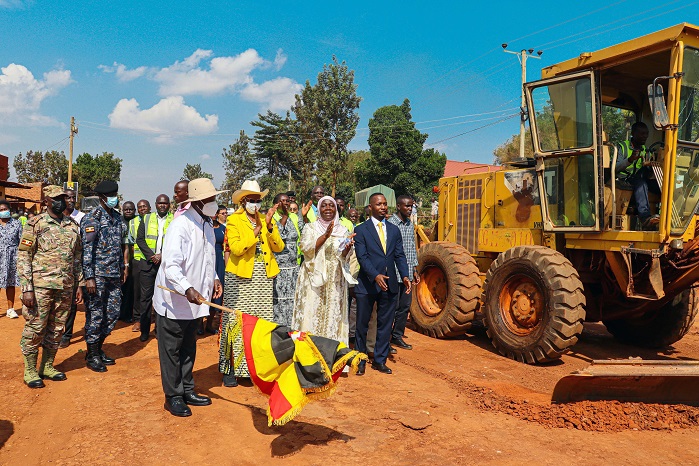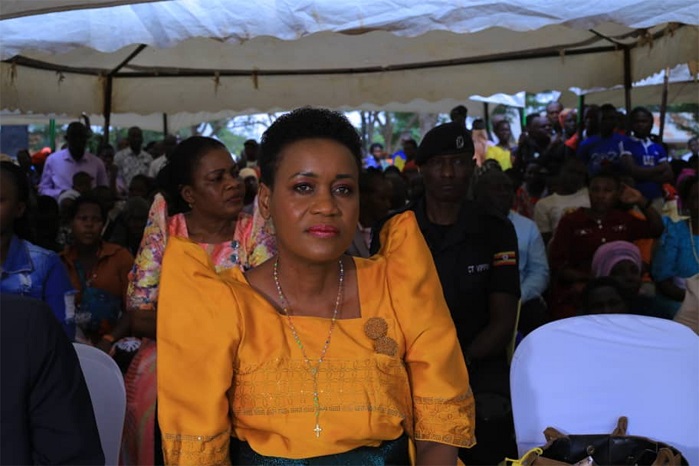
Kyankwanzi districts inhabitants cheer during the recently held International Women’s Day celebrations
HABARI DAILY I Kampala, Uganda I The International Women’s Day Celebrations, which fall on March 8 every year, is known to draw crowds, including leaders from both central and local Governments, in addition to religious, cultural and opinion leaders.
Each year, a district is selected to host these celebrations, where leaders from both local and central Governments take part, in addition to religious, cultural and opinion leaders. This year’s National Celebrations were held in Kyankwanzi district.
It’s a unique district composed of different ethnic groups, multi lingual and several income generating activities, which have gone a long way towards boosting people’s livelihood.
According to records, there has been both internal and external migration to the district in the last 15 years.
Kyankwanzi lies in the cattle corridor of Uganda and the main road from Kampala to Hoima divides the district into two main parts, the predominantly cattle rearing community commonly referred to as Balaalo in the East and the crop growing area on the western side of the road.
Kyankwanzi District is a cosmopolitan district consisting mainly of Baganda, Banyoro, Banyakole, Banyarwanda, Alur, Basoga, Lugabara, Bagishu, Bafumbira and some other smaller tribes scattered all over. Baganda has the highest population compared to others.
The Banyoro are mainly found in areas of Nsambya, Butemba and Kyankwanzi, while the Banyakole occupy areas such as Kyankwanzi, Butemba and Nsambya.
The Bakiga, are mainly found in locations such as Nsambya, Gayaza and Ntwetwe, while the Basoga occupies areas of Nsambya and Butemba. Banyarwanda can be found in locations like Kyankwanzi, and to other cattle keeping areas.
What makes Kyankwanzi unique is the fact that it was carved out of Kiboga District in July 2010. The district is sparsely populated, making it a rife cattle corridor and strategic place to carry out agriculture.
Population
According to the Uganda Bureau of Statistics (UBOS), by 2024, the total population of Kyankwanzi district was 278, 290 of which 140,501 are males and 137,789 females with a 3% growth rate.
In its [2024] Population and Housing Census, UBOS reports that the total number of households by 2024 was 69,572 and average household size is 4.
“The youth aged between 18-35 years constitute 25%. While Children below 17 are 54.4%. The district has a fertility rate of 6.5% compared to the national average of 3.4%,” says UBOS.
The settlement patterns and distributions in Kyankwanzi District indicate that the majority of the population in the district (94.8%) lives in rural areas.
Heavy/nucleated settlement is common in valley bases and in trading centres/towns of Bukwiri, Katababirwa, Ntunda, Masodde and Ntwetwe Town Council.
Along the highway (Kampala- Kyankwanzi – Hoima road) and other roads, a linear type of settlement is common.
Scattered settlements also occur in encroached wetland areas, forest reserves and the cattle corridors of Kyankwanzi, in sparsely populated sub counties with scattered population, the population density is 7 persons per sq. Km. The district has a total land area of 2,326km2.
Economic activities
Majority of the population in Kyankwanzi district engages in subsistence and commercial agriculture where cultivation of maize, cassava, beans, bananas, sweet potatoes and coffee is dominant.
A considerable number of the population is also involved in livestock production especially rearing cattle, goats, poultry and pigs.
There are four vibrant livestock markets (Lubiri in Kyankwanzi Sub County, Mbali in Nsambya Sub County, Katanabirwa in Butemba Town Council and Lwanyetta in Wattuba Sub County.
Of recent, the milk industry has picked up and most farmers are now up grading their herds for better economic income. Kyankwanzi district is also among the major maize producing districts in Uganda.
Youths are mainly employed in Boda-Boda industry. The district has on several occasions been affected by quarantine imposed by MAAIF, due to an outbreak of Foot and Mouth disease (FMD).
This disease usually affects the livelihood of very many people and the district local revenue base. Massive vaccination through support from MAAIF has brought the FMD under control.




